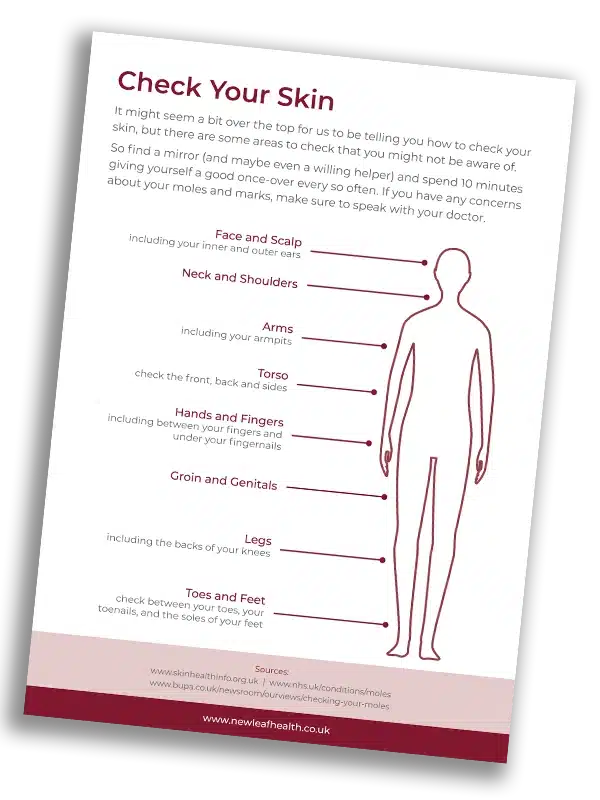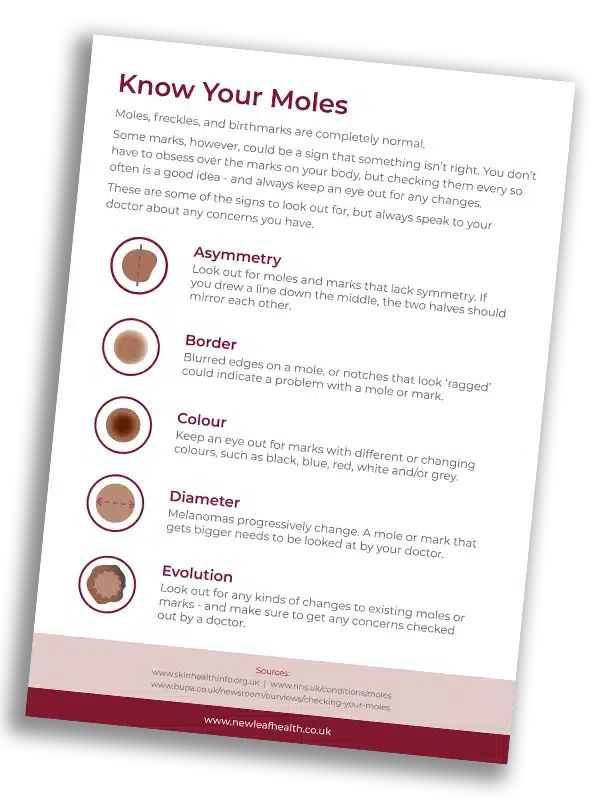
Mole Check Guide - Free Downloadable Resource
Our free Mole Check Guide gives you clear and helpful instructions on checking for signs of cancerous moles on your body.

Fill out the Form and Download the Free Guide
How Our Free Mole Check Guide Helps You
Melanoma is a type of skin cancer and is one of the most common cancers in the UK. In fact, its prevalence has more than double in the last 30 years. Whilst survival rates are high, developing skin cancer is still a serious condition.
Almost 9 in 10 cases of melonoma can be prevented through proper sun safety and awareness. Part of that awareness is knowing what cancerous moles look like so that you can get any problems checked out by your doctor straight away. Knowing where to look on your body and what to look for is absolutely crucial to early detection, so we’ve put together a handy guide to help you know what to do.
Fill out the form above to download your free mole check guide today 👆
Are Moles Cancerous?
Moles are fairly common and are usually nothing to worry about, unless they change size, shape or colour.
According the NHS, it’s normal for:
- Babies to be born with moles.
- New moles to appear – especially in children and teenagers.
- Moles to fade or disappear as you get older.
- Moles to get slightly darker during pregnancy.
It’s usually when moles start to change for no clear reason that they can become a problem – which is why it’s so important to check your skin regularly. Download our free guide to find out exactly where you should be checking.
If you’re concerned about any moles or marks on your skin, your GP can check them out for you.

UK Skin Cancer Statistics
Melanoma skin cancer has an 87% survival rate.
Skin cancer incident rates have more than doubled since the 1990s.
86% of melanoma skin cancer cases are preventable.
What do Cancerous Moles Look Like?
When on the lookout for cancerous moles, there a few different factors to consider about their appearance. You can remember these as ABCDE:
- Asymmetry – moles should be symmetrical.
- Border – they should have a clear border/edge.
- Colour – they should usually be one colour.
- Diameter – they should stay the same size.
- Evolution – they shouldn’t change over time.
Click below to download our free mole check guide, where we go into more information on cancerous moles, freckles, and birthmarks.

Cancer Awareness for the Workplace
Cancer is one of the most prevalent diseases in the UK. Whilst our Mole Check Guide is a great start for identifying potential melanoma symptoms, there are many other types of skin cancer, let alone cancers in general.
Knowing the symptoms of various cancers, along with how to access the proper screening services, can be lifesaving knowledge. Host a cancer awareness workshop for your organisation to help your staff get to know key signs and symptoms – with specific men’s and women’s options available. Click below to find out more.
